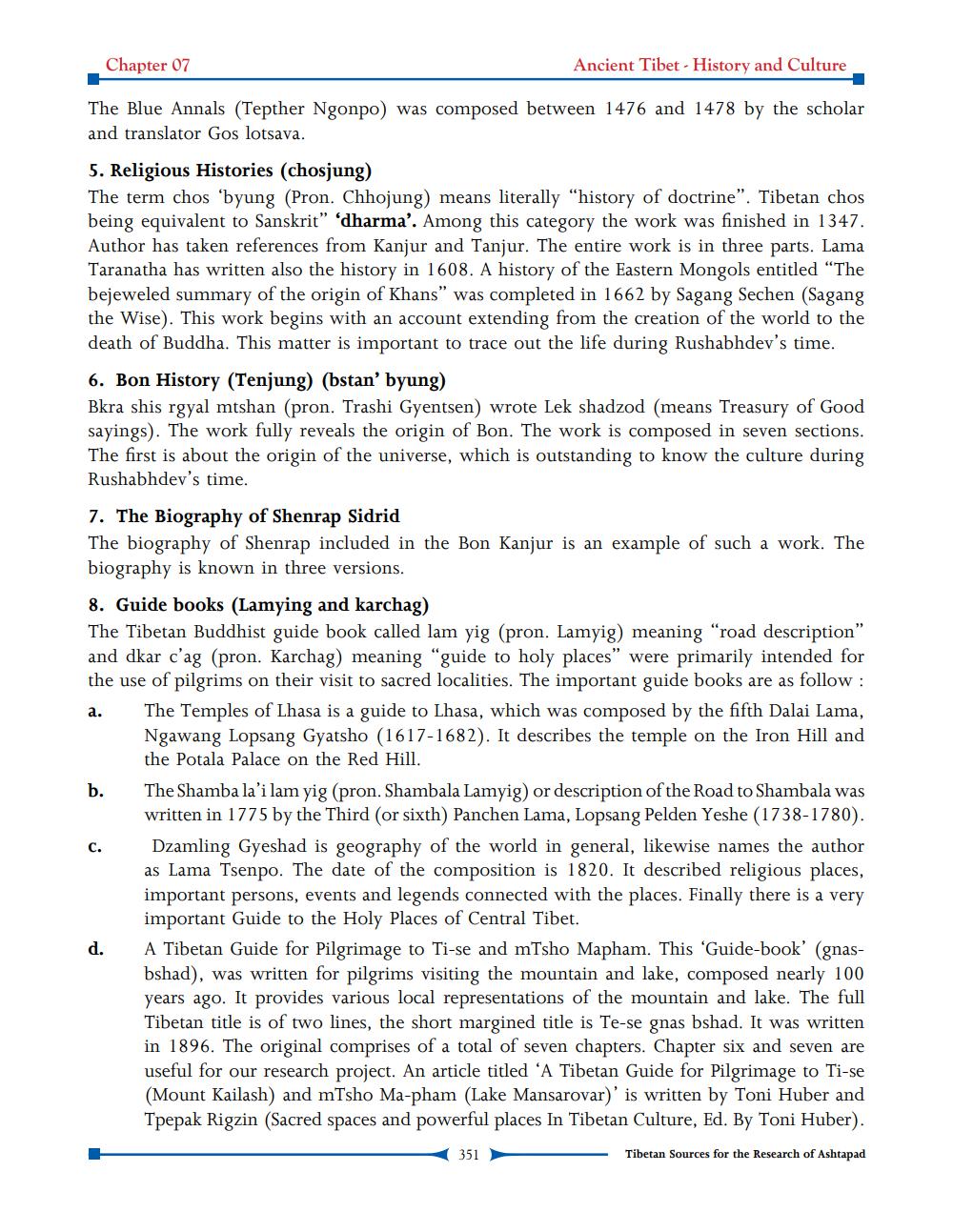________________
Chapter 07
Ancient Tibet - History and Culture
The Blue Annals (Tepther Ngonpo) was composed between 1476 and 1478 by the scholar and translator Gos lotsava.
5. Religious Histories (chosjung)
The term chos 'byung (Pron. Chhojung) means literally "history of doctrine". Tibetan chos being equivalent to Sanskrit" "dharma'. Among this category the work was finished in 1347. Author has taken references from Kanjur and Tanjur. The entire work is in three parts. Lama Taranatha has written also the history in 1608. A history of the Eastern Mongols entitled "The bejeweled summary of the origin of Khans" was completed in 1662 by Sagang Sechen (Sagang the Wise). This work begins with an account extending from the creation of the world to the death of Buddha. This matter is important to trace out the life during Rushabhdev's time.
6. Bon History (Tenjung) (bstan' byung)
Bkra shis rgyal mtshan (pron. Trashi Gyentsen) wrote Lek shadzod (means Treasury of Good sayings). The work fully reveals the origin of Bon. The work is composed in seven sections. The first is about the origin of the universe, which is outstanding to know the culture during Rushabhdev's time.
7. The Biography of Shenrap Sidrid
The biography of Shenrap included in the Bon Kanjur is an example of such a work. The biography is known in three versions.
8. Guide books (Lamying and karchag)
The Tibetan Buddhist guide book called lam yig (pron. Lamyig) meaning "road description" and dkar c'ag (pron. Karchag) meaning "guide to holy places" were primarily intended for the use of pilgrims on their visit to sacred localities. The important guide books are as follow:
a.
b.
C.
d.
The Temples of Lhasa is a guide to Lhasa, which was composed by the fifth Dalai Lama, Ngawang Lopsang Gyatsho (1617-1682). It describes the temple on the Iron Hill and the Potala Palace on the Red Hill.
The Shamba la'i lam yig (pron. Shambala Lamyig) or description of the Road to Shambala was written in 1775 by the Third (or sixth) Panchen Lama, Lopsang Pelden Yeshe (1738-1780). Dzamling Gyeshad is geography of the world in general, likewise names the author as Lama Tsenpo. The date of the composition is 1820. It described religious places, important persons, events and legends connected with the places. Finally there is a very important Guide to the Holy Places of Central Tibet.
A Tibetan Guide for Pilgrimage to Ti-se and mTsho Mapham. This 'Guide-book' (gnasbshad), was written for pilgrims visiting the mountain and lake, composed nearly 100 years ago. It provides various local representations of the mountain and lake. The full Tibetan title is of two lines, the short margined title is Te-se gnas bshad. It was written in 1896. The original comprises of a total of seven chapters. Chapter six and seven are useful for our research project. An article titled 'A Tibetan Guide for Pilgrimage to Ti-se (Mount Kailash) and mTsho Ma-pham (Lake Mansarovar)' is written by Toni Huber and Tpepak Rigzin (Sacred spaces and powerful places In Tibetan Culture, Ed. By Toni Huber).
Tibetan Sources for the Research of Ashtapad
351




